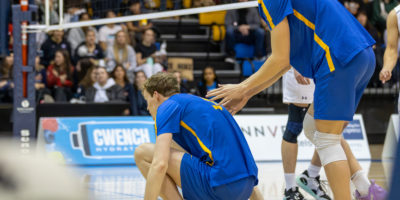By Diane Peters
A red nose, big shoes and funny clothes do not make a clown—it takes a hat, training, experience, laughter and tears.
Sue Morrison, artistic director of the Theatre Resource Centre, says the process of being a clown is an enlightening one: “If you ever face all directions of yourself at once, you can only laugh at the sheer beauty of your own ridiculousness. When you watch a great clown, you have the feeling of laughing and crying at the same time.”
TRC was started in 1975 by Richard Pochinko and Ian Wallace. It began and continues to be “a place for artists in the city to come and work pieces out in a non-judgemental forum.” These pieces include theatre, motion, music and clowning.
TRC is also the home of the “Clowning through Mask” workshop. It, and other clown workshops, teach the techniques developed by Pochinko by combining European and North American Indian traditions.
In the native tradition, the clown was the messenger of the gods. A clown, like the fool in a medieval court, was above leaders and could speak truthfully and ridicule the leader when he was out of line. Literature and theatre use the clown, the fool and the simpleminded person similarly. “The clown is the conscience of the play,” says Morrison. They appear stupid on the surface, but are the only ones who see and speak honestly.
The native clown tradition says there are six directions: north, south, east, west, above above and below below. Actors in the “Clowning Through Mask” workshop make a mask and explore these directions. They also dig into their own past and neuroses to reach a place between innocence and experience using action and humour.
Morrison discovered this magic 15 years ago, when she came to TRC after she saw a flyer for the “Clowning through Mask” workshop. She’d been working at Second City and was looking for a way to work not from her head, but her heart.
Clowning changed the way Morrison works and lives. She finds the philosophies of the art pervade her life now. The technique of looking deep into yourself, without judgement, and laughing at things helps her live better and creates, she feels, the ultimate form of theatre.
Ten years ago she became Pochinko’s apprentice. Since clowning techniques are mainly taught orally, it was the only way to carry on the tradition. After Pochinko died six years ago of AIDS. Morrison became artistic director of TRC and began teaching.
Beside the workshops, the TRC maintains a commitment to all performing arts. Its monthly “Soirees” showcase works in progress by various artists. Since much of these shows are improvisational, there’s always variety, risk and lots of audience involvement. This month is called “Live, Raw and Risky” and it’s on Saturday March 25 at 317 Adelaide St W #501.
Another project on the go is “Come Back to the Five and Dime Anton Chekov, Anton Chekov.” Morrison is co-directing it with Nick Johne. The play will feature Toronto Pochinko clowns doing a workshopped amalgamation of some Chekov plays, all set in a diner. It starts May 3rd.
While Morrison thinks a clown can wear anything, and that costumes are not made to cover up but to reveal character, Morrison insists all her clowns wear hats.
“Since a clown is open to everything, a hat provides protection against the shit. It makes me nervous when I see a clown without a hat.”











Leave a Reply